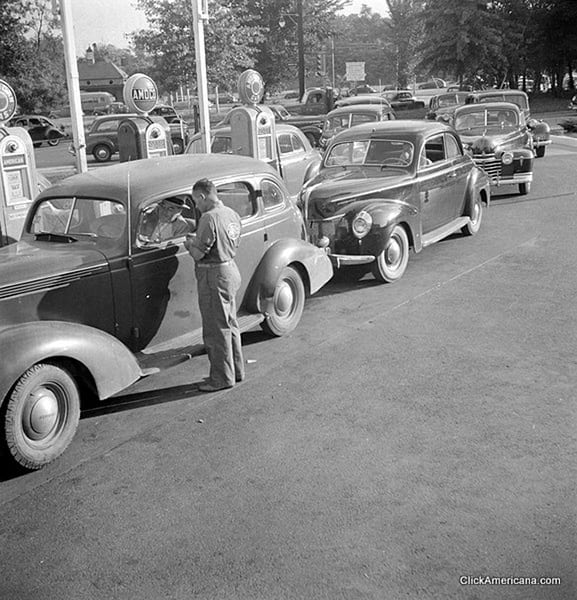Home »
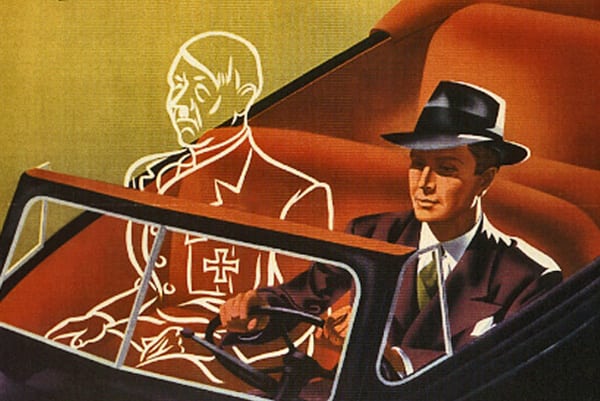
When driving alone was forbidden
By Elinor Florence
 Today’s reliance on fossil fuels has made us mindful of how much gasoline we are burning. But what if we weren’t legally allowed to buy gas or tires for our cars – or even a new car? That was the case for thousands of Canadians in wartime who were saving every drop of fuel for the war effort.
Today’s reliance on fossil fuels has made us mindful of how much gasoline we are burning. But what if we weren’t legally allowed to buy gas or tires for our cars – or even a new car? That was the case for thousands of Canadians in wartime who were saving every drop of fuel for the war effort.
When the Second World War began in 1939, Great Britain began rationing “petrol” almost immediately. Not only was every drop of fuel needed for military vehicles, but also the blockade of the Atlantic by German submarines meant it was difficult to import fuel and food and everything else.
At first, Canadians reduced their gas consumption voluntarily. Then gasoline rationing began here in April 1942, and that was followed one month later by the United States. Once again, I’m reminded how much more deprivation the British people suffered than we did here in North America.
On the last day before strict rationing took effect, car owners lined up their empty vehicles at local stations. (That seems to defeat the purpose, but I understand why you would want to purchase every drop while you still had the chance.)
Here’s a photo of cars in Washington, D.C. parked in front of gas stations long before they opened, waiting to fill their tanks. Cars were parked and left without their drivers, who returned at eight o’clock in the morning when the gas station opened for business.
Just as for food and clothing, ration books were issued, and each time you filled up in Canada you had to fork over a number of your precious gasoline coupons. And I do mean precious! Owners of non-essential vehicles were allowed only 120 gallons of gas a year. Back then, this was the equivalent of just 2,000 miles.
When gas rations took effect in Canada, some people simply put their cars into storage for the rest of the war. One of them was my grandfather Charlie Light, who walked five kilometres every day from his home on the edge of Battleford, Saskatchewan, to his job as postmaster at the Battleford Post Office. His wife and five children walked everywhere as well. I can’t help thinking how very healthy and fit they must have been!
Here’s a photo of the 1928 vehicle. It was already 14-years-old when he parked it in 1942, and even older when the war ended.
Walking was encouraged in a big way, and not for the sake of fitness. Here’s a poster from Britain urging people to use “shank’s pony,” which is an old-fashioned term for walking.
Here’s an American poster urging housewives to carry their groceries rather than taking them home in a vehicle. In spite of their willingness to help the fighting men, it must have been a hardship for mothers with young children, or elderly people, to walk everywhere.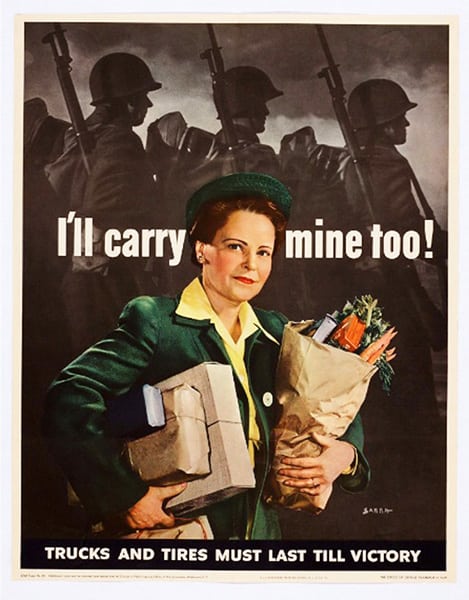
Gas rationing was intended to curb driving, in order to conserve rubber as much as gasoline. Japanese conquests in Asia had cut off our access to natural rubber. Tires were also rationed and civilians couldn’t purchase them unless they could prove that driving was essential – as in farm labour, or commercial freight transport, or ambulances. Speed limits were reduced to cut wear and tear on tires, and make them last.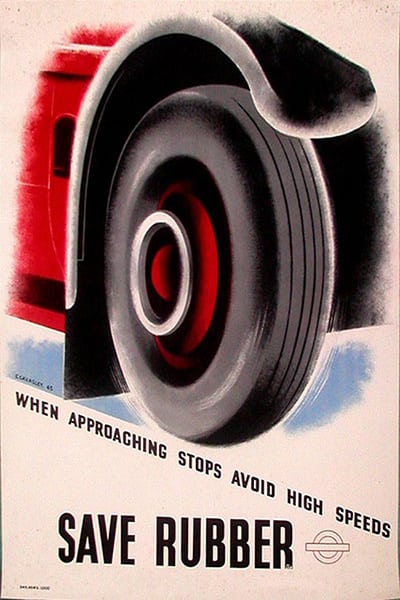
The rubber shortage even affected people’s underwear! Elastic waistbands gave way to underpants with a single button on the side, called “step-ins.” My mother recalls a very funny incident when the doctor’s wife in Battleford stood up to sing a hymn, the button popped, and her step-ins fell to her ankles! Without missing a beat, she stepped out of her step-ins, shoved them into her bag, and kept on singing.
Lou Marr of Windermere was a member of the Royal Canadian Air Force Women’s Division, and told me about the time her garter belt gave way and her stockings drifted down to her ankles – while she was lined up on parade!
Read my interview with Lou here
Factories weren’t even making new cars any longer – they had all been converted to manufacturing jeeps, tanks and bombers. So you couldn’t buy a new car because there was no such thing. In 1942, domestic automobile production ground to a halt.
This photo shows workers at Ford of Canada putting the finishing touches on the last civilian automobile, a Mercury 8, just before midnight on March 31, 1942.
Because people were walking everywhere, hitchhiking became very common. This sign, placed on the car’s dashboard or stuck to a window, indicated that the driver was happy to give a ride to anyone in uniform.
With so few vehicles on the roads, car pools became popular, although they didn’t call it a car pool back then, but a “car club,” presumably because people were clubbing together to save on gas.
In wartime, there was no such thing as a special lane for drivers with passengers, the way there are now on many city freeways. Probably there weren’t enough roads with multiple lanes to make it worthwhile. But it certainly was encouraged to carry somebody with you if you had an extra seat in your vehicle. This poster urges people to “Double Up.” (Propaganda posters played heavily into people’s fear and guilt, you will notice.)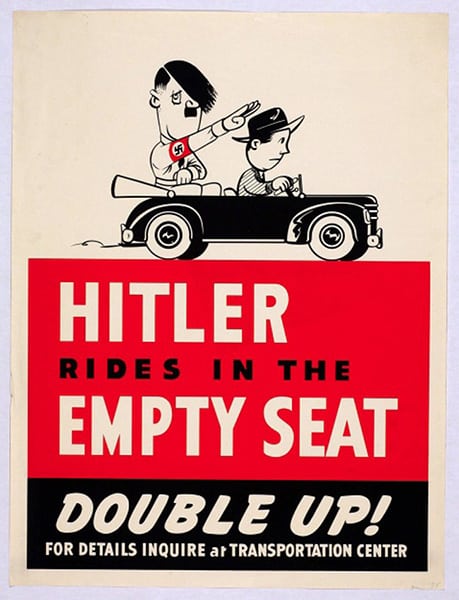
And this poster from the American Legion urges people to do a lot more than Double Up! It wanted drivers to pack in as many passengers as possible.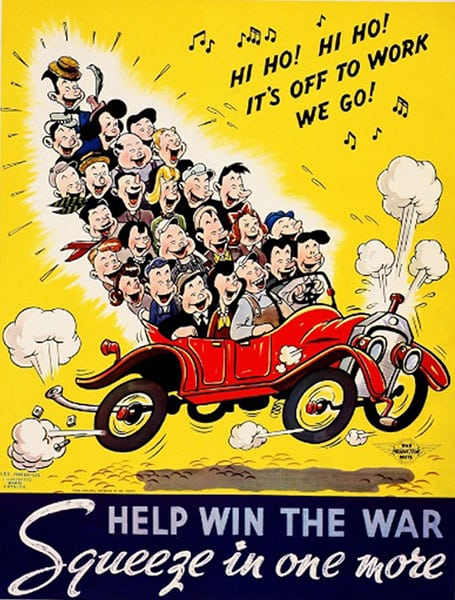
This poster really tugs at the heartstrings, playing on people’s sympathy as they reminding civilians of who they were making the sacrifice for – the fighting man.
Even using public transportation was discouraged, because that, too, wasted valuable resources. I don’t mean flying around in airplanes, or taking cruises on ships. All civilian travel by air and sea was banned. I’m just talking about taking a ride on a train, or even a Greyhound bus. That, too, was frowned upon.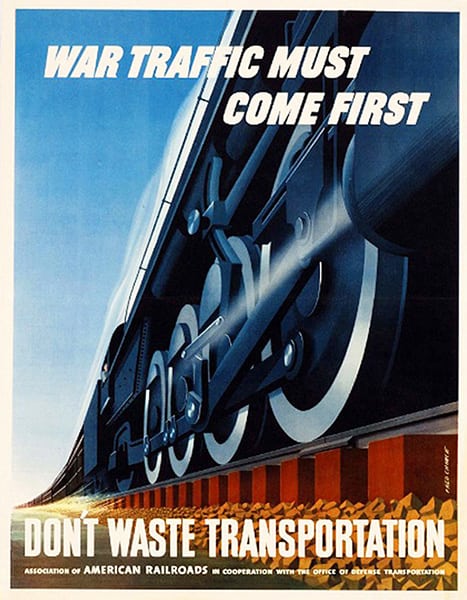
In fact, the government would have been happier if everyone would have just stayed home. And many of them did!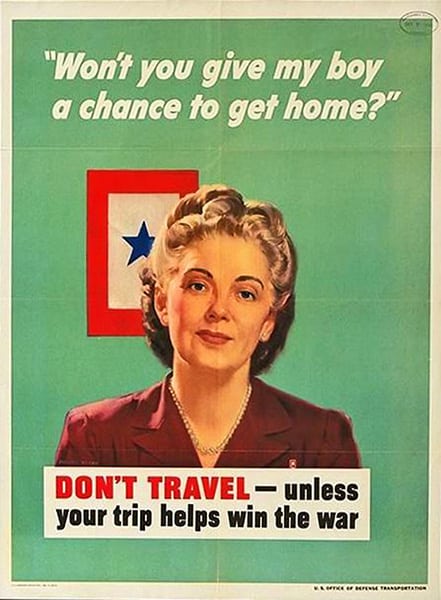
I wasn’t able to find a breakdown of just how much fuel was used per capita compared with today – but I’ll bet it was astounding. Canadians back then saved on precious fossil fuels because they had no choice.
Perhaps we can learn a lesson from the past. If we ever run that short of fuel, we can do without it again. There’s always the trusty shank’s mare. Or even the old mare herself!

– Career journalist and bestselling author Elinor Florence of Invermere has written two wartime books. Her novel Bird’s Eye View tells the story of an idealistic Saskatchewan farm girl who joins the Royal Canadian Air Force and becomes an interpreter of aerial photographs. My Favourite Veterans is a non-fiction collection of interviews whose stories appeared previously on e-KNOW, including Cranbrook’s own Bud Abbott.
Elinor’s new novel Wildwood, about pioneer life in the Peace River, Alberta region, will appear in February 2018. It is available for pre-order now at a reduced price on Amazon. For more information about all three books, visit Elinor’s website at www.elinorflorence.com or call her at 250-342-1621.
